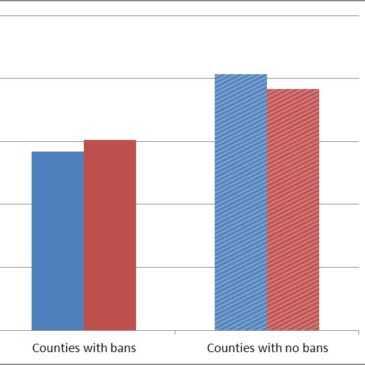Smoking bans and other public health initiatives have been effective at decreasing smoking (see ASHES 9(5)) as well as possibly reducing the rate of alcohol use disorders (See The DRAM 9(7)). However, the specific relationship between smoking bans and drunk driving has not been thoroughly explored. It is possible that individuals might drive longer distances to bars outside their county in order to smoke, potentially increasing the risk of drunk driving. This week, as part of our Special Series on Driving Under the Influence of Intoxicants, we review a study that examined how drunk driving fatalities have varied with the adoption of smoking bans (Adams & Cotti, 2008).
Methods
- Researchers analyzed data collected by the National Highway Traffic Safety Administration (NHTSA) Fatality Analysis Reporting System (FARS) from 2000-2005.
- The researchers identified fatal traffic accidents where the driver had a blood alcohol content (BAC) exceeding 0.08.
- To measure smoking bans, the researchers identified counties with smoking bans enacted from 2000-2005 and recorded the year of the ban (counties with a smoking ban: n=117; counties without a smoking ban: n=2,335).
- They excluded counties with no fatal accidents.
- The researchers analyzed the effects of the smoking bans with a regression model.
- The model estimated how rates of fatal accidents changed across time in counties that enacted smoking bans, compared to those that did not.
- The researchers controlled for population changes, accident trends, and DUI policies, among other variables.
Results
- As Figure 1 shows, counties with smoking bans had higher rates of alcohol-related traffic accidents after the bans were enacted.
- On the other hand, counties without bans had lowered rates in the second half of the study period when compared to the first half.
- The model demonstrated that the differences shown in Figure 1 were robust; the change in rates of alcohol-related crashes across time differed significantly between counties with smoking bans (in which rates increased) and those without (in which rates decreased).
- After controlling for population changes, accident trends, and DUI policies, the researchers observed a 13.44% increase in alcohol-related accidents after counties instituted smoking-bans.
Figure. Rates of Alcohol related traffic accidents in counties with and without smoking bans. Click image to enlarge.
Limitations
- Incomplete BAC data in FARS may have led to an underestimate of the number of alcohol-related crashes.
- The authors omitted counties with zero fatal accidents, possibly biasing the results towards a stronger effect.
Conclusion
The results of this study suggest that smoking bans might lead to higher rates of alcohol-related accidents. This could be due to individuals driving further distances to avoid the ban. However, a more recent study also using FARS data failed to find any significant relation between smoking bans and alcohol-related crashes (Bernat et al. 2013). The key differences between the two studies were geographic unit of the analysis (Bernat examined smoking bans on at a state, rather than county level) and the model used to analyze the data. It is possible that the effect seen in Adams and Cotti (2008) is only applicable at the county level, where the driving distances required to find alternate bars are still practical. Additionally, this effect might become less relevant as smoking-ban policies become standard at a statewide level.
– Jed Jeng
References
Adams, S., & Cotti, C. (2008). Drunk driving after the passage of smoking bans in bars. Journal of Public Economics, 92(5), 1288-1305.
Bernat, D. H., Maldonado-Molina, M., Hyland, A., & Wagenaar, A. C. (2013). Effects of smoke-free laws on alcohol-related car crashes in California and New York: Time series analyses from 1982 to 2008. American Journal of Public Health, 103(2), 214-220.
What do you think? Please use the comment link below to provide feedback on this article.





